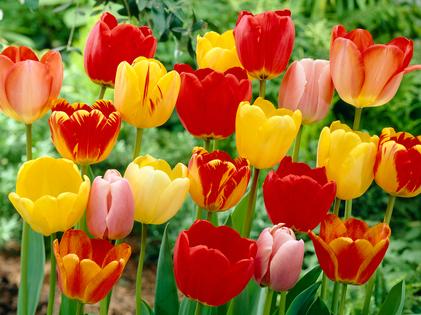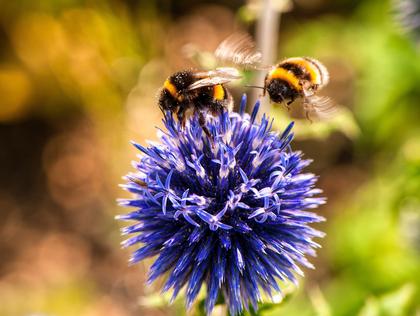
Pollinator-Friendly Bulbs for your Garden
How exciting to see those first spring bulbs, planted last fall, peeking up out of the landscape to signal the coming of the new season. After a dreary winter, such color is a welcome sight. But imagine how significant they are to pollinators just coming out of hibernation or arriving after migration! By providing nutrient-rich nectar or pollen, pollinator-friendly bulbs may contain some of the few food sources available at this time. Supporting these pollinators is critical to maintaining a sustainable environment, one that provides diversity in plants and an abundance of the foods we eat. Living pollinators (bees, wasps, moths, butterflies, birds, beetles, flies, ants and bats) are responsible for the reproduction of most terrestrial seed plants, and the production of most fruits and vegetables.

Planting early-blooming bulbs into your garden ensures that pollinators are able to feed before other native nectar sources are readily available. Your entire garden will benefit from these early flowering bulbs by helping to establish a resident pollinator population that may stay all summer. Together, you and your neighbors may create corridors of beneficial habitat. Include some summer and fall flowering bulbs too.
Consider these points when creating a pollinator garden with bulbs:
- Species, especially native, bulbs are most likely to provide for the needs of our pollinators. Highly hybridized plants with extravagant flowers may have too many anatomical changes to be useful.
- Planting in clumps of several plants of the same type will attract more pollinators.
- Choose a variety of different flower shapes and colors to accommodate a greater number and diversity of pollinators.
- Use a variety of plants and bulbs which bloom in different seasons.
- Eliminate pesticides when possible or try the least toxic option first. Don’t spray when pollinators are active.
- Please don’t dig plants from the wild - buy only nursery propagated bulbs.
Here is a list of the best bulbs, corms and rhizomes for supporting pollinators. These represent much variety in plant forms and flower forms and colors, and all would be beautiful additions to a garden. Most are also quite fragrant. Many of them are hardy to USDA zone 3 but extreme southern gardens do not have cold enough winters for some to continue past the first season. You should verify the hardiness of varieties for your area. Listed bloom time is approximate and may be generalized for multiple varieties.
- Ornamental Onion (Allium) - Blooms late spring to early summer, with a comparatively long bloom time. Full sun; tolerates some shade. Supports bees and butterflies.
- Anemone (Anemone) - Blooms spring to early summer, or late summer to fall. Full to part sun. Supports bumblebee queens, solitary bees and hoverflies.
- Daffodils (Narcissus) - Blooms spring. Full to part sun. The best daffodils for pollinators are the wild types such as Narcissus poeticus and N. jonquilla. Supports bees and butterflies.
- Fritillaria (Fritillaria) - Blooms spring. Full sun with partial sun where hot. Supports birds, flies, wasps and bees.
- Grape Hyacinth (Muscari) - Blooms spring. Full sun to dappled shade. Plant as bulbs in fall; they may also be available in pots in spring. Supports bees and butterflies.
- Snowdrops (Galanthus)- Blooms early to late spring. Full to part sun. Plant as a dormant bulb in fall or as a plant in spring. Supports bees and flies, and later the seeds feed ants.
- Tulips (Tulipa) - Blooms spring. Full sun. Species tulips are better choices for pollinators and more reliable rebloomers than their hybridized counterparts. Supports bees and hoverflies.
- Bluebells (Hyacinthoides) - Blooms spring. Dappled shade and slightly moist soil. Supports bees, butterflies and hoverflies.
- Crocus (Crocus) - Blooms early spring or fall. Full sun. The purple-flowered varieties are purported to be the most popular with bees.
- Glory of the Snow (Chionodoxa) - Blooms early spring. Full to part sun. Supports bees and hoverflies.
- Winter aconite (Eranthis) - Blooms early spring. Full to part sun. Supports bees and hoverflies.
- Common Hyacinth (Hyacinthus) - Blooms spring. Full sun (best) or dappled shade. Usually planted in fall but may also be available as a potted plant in spring. Multiple blooms on a stalk make them very attractive to pollinators. Supports bees.
- Iris (Iris) - Blooms spring (most types). Full sun. Supports bees, butterflies and hummingbirds.
- Squill (Scilla) - Blooms late winter to early spring. Full to part sun. Supports bees.
- Crocosmia (Crocosmia) - Blooms summer. Full sun; part shade in hot areas. Supports hummingbirds, other birds and butterflies.
- Lily of the Nile (Agapanthus) - Blooms summer. Full to part sun. Supports bees and hummingbirds.
- Red Hot Poker (Kniphofia) - Blooms summer. Full sun. Supports butterflies and hummingbirds.
- Bleeding Heart (Dicentra) - Blooms late spring or early summer. Part shade. Dutchman’s britches (D. cucullaria) is an important food source for bumblebee queens. When the young worker bees emerge later in the season, they are important pollinators for other plants. D. eximia is longer-lived through the summer and will feed hummingbirds, butterflies and bumblebees.
- Virginia Bluebells (Mertensia virginica) - Blooms early to mid-spring. Full to part shade. Supports bumblebees and other long-tongued bees, butterflies, skippers, hummingbird moths, flower flies (syrphids), bee flies and hummingbirds.
- Trout Lily (Erythronium americanum) - Blooms spring. Full to part shade. Supports bees.
- White Trillium (Trillium grandiflorum) - Blooms spring to early summer. Full to part shade. Supports honeybees, bumblebees and wasps.
- Jack-in-the-pulpit (Arisaema triphyllum) - Blooms spring. Full to part shade; moist to wet soil. Pollinated by insects as they are trapped by the hood and climb out through a bottom hole past the pollen. Supports fungus gnats and flies.
- Mayapple (Podophyllum peltatum) - Blooms spring. Full to part shade. Supports bumblebees and honey bees.
- Spring Beauty (Claytonia virginica) - Blooms early spring. Full sun to part shade. Supports bees and flies.
Many of these plants are also deer resistant. You can find more information about them in the blog “Top 12 Deer Resistant Flower Bulbs”.
On a global scale, pollinators are declining in numbers due to habitat loss, loss of their natural plant associations due to invasive plant species, parasitic infection and pesticide use. Adding pollinator-friendly plants, especially the early flowering bulbs, to our gardens can help restore pollinator populations and ensure a more sustainable world.
Latest Posts
Latest Posts
-
August 03, 2020Chris Ruigrok
-
July 02, 2020Patricia Vecchio
-
May 28, 2020Patricia Vecchio




